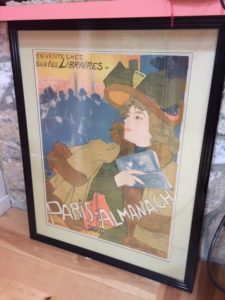 TG owns a Belle Epoch lithograph poster from Paris, and wants to know its relationship to Art Nouveau, which she loves. A huge relationship exists between the poster design of the era and the great movement of the early 20th century called Art Nouveau.
TG owns a Belle Epoch lithograph poster from Paris, and wants to know its relationship to Art Nouveau, which she loves. A huge relationship exists between the poster design of the era and the great movement of the early 20th century called Art Nouveau.
The late 19th century became a hotbed of talent in the world of design in Europe, the first international form of design. The idea of the artist as a MAKER, not of one specific TYPE of object, but a maker of good design, influenced those in that day. By its use, the concept uplifted mankind.
In the Art Nouveau era, an artist considered themselves an artist NOT JUST in oils on canvas, but a maker who achieved newness. In fact they also achieved greatness in two-dimensional work, AND furniture, jewelry design, glass, ceramic, fabric, and metal. The late 19th century to early 20th century became the era of the artist as designer. They felt more than open to the influence of fellow makers, and actively borrowed motifs across national borders.
An Art Nouveau Artist
The artist of TG’s poster, Joseph van Sluytens, who created under the name Georges de Feure (1869-1943), a Dutch/French artist often called a free spirit. His talent for free-spirited-ness emerged early on, and he received a prestigious art school position in Holland. Yet he quickly left for Paris and never took another class. He sired children with both his wife and a mistress. Also he joined a very forward thinking group of artists at Siegfried Bing’s famous Maison de l ’Art Nouveau. More about that important place later. He made art in the era of Paris during the Belle Epoche, a conservative time for the nation. But a wild time for the artist in the new spirit of the age of international, bohemian, cross discipline, and collaborative.
The poster appears as mysterious as the artist. It advertises a guidebook to Paris attractions published by Ed Sagot, shown in the lovely hands of a lone traveling woman, glancing over her shoulder at the mostly male throng on the Paris streets. De Feure created the poster in 1894, the golden era of advertising posters, in which luminaries like Toulouse Lautrec worked. The Wagner family donated their whole collection to LACMA “Posters of the Belle Epoche.”
The words below the figure give the name of the publisher, Bourgerie & Cie. I see the paper looks ‘right’ for an original poster of this era, and valued $1,200-1,600. Modern reproductions go for $30.
Bing As A Promoter
Now to the notorious Siegfried Bing, who promoted de Feure’s work, along with other great artists, also MAKERS, of the era. An art impresario of the top order, he came from a German family with trading interests in Paris. He took over the family biz in 1873 and traded art and objet d’art from Japan, and housed his bother August in the Yokohama office to do so. In this era few KNEW of the art of Japan. Japan closed to Western eyes for centuries before. Soon the aesthetes of Paris wanted Japanese anything. Bing published a highly influential magazine about the arts of Japan, Le Japon Artistique 1888-1891.
In 1895 Bing opened a house museum-style gallery in downtown Paris in a redesigned Maison. He decorated each room in the Art Nouveau style, each object he put up for sale. He pioneered the look which became the first international style, Art Nouveau. Henry van de Velde did the interiors, and Tiffany, the glass and windows.
During the heyday of the Maison de l ‘Art Nouveau, 1892 -1902, Bing sold fabrics by Briton William Morris, Tiffany glass, Rookwood pots from Cincinnati, Grueby Faience of Boston, paintings by the Les Nabis (Bonnard, Vuillard, Denis, Serusier, Ranson, Vallotton), and artists Bonnier, Brangwyn, designers Gaillard, Colonna, Benson, and De Feure; an international collective. He sold art, jewelry, ceramics, metalwork, stained glass, and furniture to private buyers and to world museums. Check out this book about his era, The Origins of l‘Art Nouveau: The Bing Empire. He dressed in traditional Japanese attire. If I stepped back in time, I’d love to meet Bing, and feel the excitement of a new movement in MAKING design, and of course wear those clothes.